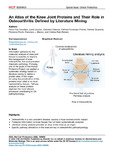An atlas of the knee joint proteins and their role in osteoarthritis defined by literature mining

Use este enlace para citar
http://hdl.handle.net/2183/33428
Excepto si se señala otra cosa, la licencia del ítem se describe como Creative Commons Attribution 4.0 International License (CC-BY 4.0)
Colecciones
- Investigación (FFISIO) [475]
Metadatos
Mostrar el registro completo del ítemTítulo
An atlas of the knee joint proteins and their role in osteoarthritis defined by literature miningAutor(es)
Fecha
2023-08Cita bibliográfica
Paz-González R, Lourido L, Calamia V, Fernández-Puente P, Quaranta P, Picchi F, Blanco FJ, Ruiz-Romero C. An atlas of the knee joint proteins and their role in osteoarthritis defined by literature mining. Mol Cell Proteomics. 2023 Aug;22(8):100606.
Resumen
[Abstract] Osteoarthritis (OA) is the most prevalent rheumatic pathology. However, OA is not simply a process of wear and tear affecting articular cartilage but rather a disease of the entire joint. One of the most common locations of OA is the knee. Knee tissues have been studied using molecular strategies, generating a large amount of complex data. As one of the goals of the Rheumatic and Autoimmune Diseases initiative of the Human Proteome Project, we applied a text-mining strategy to publicly available literature to collect relevant information and generate a systematically organized overview of the proteins most closely related to the different knee components. To this end, the PubPular literature-mining software was employed to identify protein-topic relationships and extract the most frequently cited proteins associated with the different knee joint components and OA. The text-mining approach searched over eight million articles in PubMed up to November 2022. Proteins associated with the six most representative knee components (articular cartilage, subchondral bone, synovial membrane, synovial fluid, meniscus, and cruciate ligament) were retrieved and ranked by their relevance to the tissue and OA. Gene ontology analyses showed the biological functions of these proteins. This study provided a systematic and prioritized description of knee-component proteins most frequently cited as associated with OA. The study also explored the relationship of these proteins to OA and identified the processes most relevant to proper knee function and OA pathophysiology.
Palabras clave
Knee
Osteoarthritis
Proteomics
Cartilague
Synovial
Subchondral bone
Meniscus
Cruciate ligament
Human proteome project
Chondrocytes
Synoviocytes
Nitric oxide
Apoptosis
Mitochondria
Osteoarthritis
Proteomics
Cartilague
Synovial
Subchondral bone
Meniscus
Cruciate ligament
Human proteome project
Chondrocytes
Synoviocytes
Nitric oxide
Apoptosis
Mitochondria
Versión del editor
Derechos
Creative Commons Attribution 4.0 International License (CC-BY 4.0)
ISSN
1535-9476






